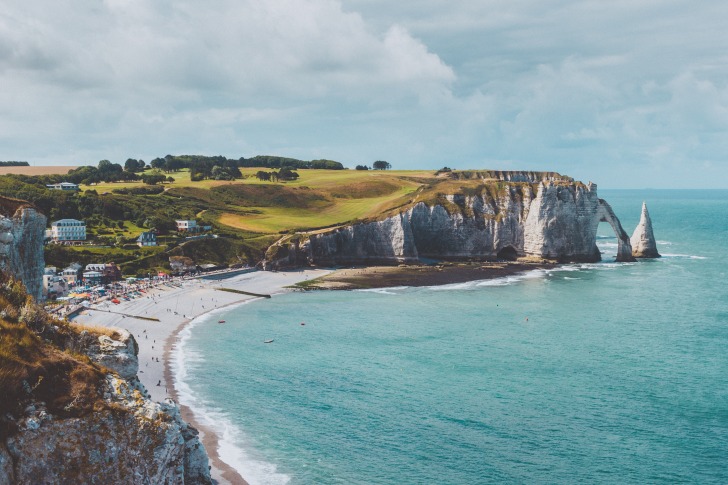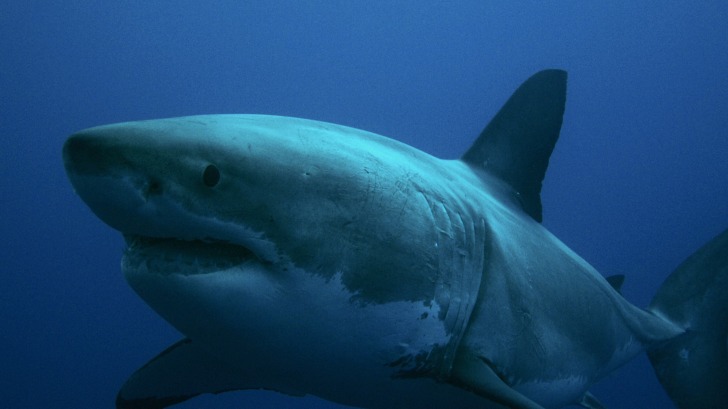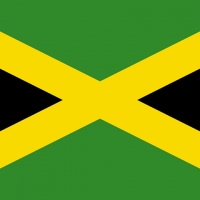Maybe I should have taken fourth-year French in high school.
I had no idea that there could be sharks in France, and maybe the French History class I didn’t take would have mentioned that.
Contents
So… Are There Sharks in France?
I found out that 47 different species of sharks may possibly swim near France.
They usually spend their time in the Mediterranean Sea.
France is northwest of that body of water, and you’ll find sharks in the Tyrrhenian Sea connected to the Mediterranean east of Italy.

1. Blue Shark
The blue shark resides in the Mediterranean sea more often than the dozens of other types that may lurk around here.
They typically like to stay “in the deep” unless they’re too young for it yet or feeling sick or have an injury.
A blue shark can grow up to 10 feet tall, but the average is 5.6 to 7.2 feet (1.7-2.2 meters).
It may weigh 454 pounds (206 kilograms).
It shocked me when I learned that a blue shark can have about 135 babies (pups) at once.
Really?
Wow.
That’s all I can say.
They begin to mate at only 3 or 4 years old, while other sharks might not mate until they’re 10-18 years of age.
By the way, the blue shark shows up not only in France but in Corsica, Spain, and other locations.
2. Gray Nurse Shark
The Gray Nurse Shark’s vicious teeth make it look scarier than it actually is.
It extends up to 10 feet long and may weigh about 191.8 pounds (87 kg) or more.
It lives in underwater reefs, continental shelf formations, or near sandy shores.
3. Basking Sharks
Basking sharks show up in various places in the Mediterranean.
They’re said to be harmless to humans.
They grow to about 26.2 feet long (8 meters), and they weigh…wow…I didn’t know this…they weigh about 11,464 pounds or 5,200 kilograms maximum.
4. Blacktip shark
The blacktip shark shows up in quite a few places in the world.
The Mediterranean is one of them.
They’re probably one of the most frequent “travelers.”
The blacktip shark can sustain itself in a variety of habitats: lagoons, coves, and reefs name a few.
They don’t go much beyond 98.4 feet (30 meters) below the water’s surface.
You won’t see them in the deep ocean, which would be impossible from land anyway.
5. Great White Shark
The Great White shark is one of the longest and largest of all shark species.
Sometimes, it grows to at least 20 feet.
They might weigh at least two tons, and they can swim at about 16 miles per hour.
I was surprised when I found out that the Great White has the most unprovoked attacks against humans.
I thought the bull shark was not the Great White, but maybe I was wrong.
This gigantic shark doesn’t show up as much as other species do though.
Besides the Mediterranean, places, where Great White sharks are spotted, include Mallorca and the Tyrrhenian Seas.
The Straight of Sicily seems to be a prime shark nursery spot too.
6. Smalltooth Sand Tiger Shark
This one shows up closer to Beirut, Lebanon than France in the Mediterranean.
It can reach lengths of about 13.5 feet (4.1 meters) and weighs up to about 635 pounds (289 kilograms).
There’s no record at all of a small-tooth sand tiger ever attacking a human.
They apparently take the “flight” action when scared instead of the “fight” one.
7. Hammerheads (3 kinds)
The Mediterranean welcomes three different primary hammerhead types: great, smooth, and scalloped.
The great hammerhead reaches about 20 feet (4 meters) maximum and averages about 13.1 feet overall.
It can weigh up to 500 pounds (230 kilograms) on average.
The most a great hammerhead ever weighed was 991 pounds (450 kilograms).
The smooth hammerhead comes in as the second largest of the main hammerhead species frequenting the Mediterranean.
It may reach about 16 feet maximum with an average length of 8-11.5 feet.
It can weigh as much as 880 pounds (400 kilograms) at 16 feet.
The average pound it puts on is about 185 pounds (83.9 kilograms) or more.
The scalloped hammerhead weighs about 185 pounds (84 kilograms).
It grows to a maximum of 14 feet but usually extends an average of 8-11.5 feet.
Is it Safe to Swim in France?
France made the top 10 of most shark attacks in Europe, having 10 total attacks.
Three of these incidences did unfortunately cause the loss of life.
It’s not such a terrible place to swim that you would have to worry about sharks all the time either.
Some places you can swim in France include Lac De St Pardoux, La Baignade, or the Butt-aux Cailles Swimming Pool.
Otherwise, try Island Recreation Vairs, Ile de Loisirs de Cergy-Pontoise.
There are others too.
Before you do swim in these waters, however, make sure the beaches have been tested.
Read water quality reports pertaining to the location you plan to visit.
This will prevent you from experiencing allergies, rashes, or contagious sicknesses because of water contamination.
Beware that France sometimes does experience tropical storms.
However, France’s position makes it less susceptible to violent typhoons, hurricanes, and windstorms than other Mediterranean countries.
You might also have to concern yourself with tornadoes in France.
However, they only come once every five years or so.
This country has only suffered about a dozen violent tornadoes since 1680.
Interesting Shark Facts in France
France does not by any means have the most shark attacks in Europe.
Italy has actually had more at about 50 since 1900 and 11 fatalities versus France’s 10 with three fatalities.
One interesting fact I learned about mosquitos versus sharks puts it in perspective.
Apparently, 800,000 mosquitos cause deaths every year, more than likely because of malaria.
Shark attacks do occur here.
People often feel shocked and terrified by the stories they hear about them.
However, they don’t happen as nearly as often as people imagine in their heads they do.
Most sharks prefer at least some salt in their water but like moderate temperatures ranging from 60-70 degrees.
You will usually find them in the Mediterranean or the Tyrrhenian Sea.
You probably could see them in inlets or canals instead of directly on the North Atlantic shore.
They do swim quite a way through.
Some species might travel 50 miles in a day.
Sharks usually can’t survive in freshwater for more than a few days.
It has to have at least some salinity because of the way its breathing systems are designed.
They will frequently pass through freshwater areas to find food though.
Most sharks have a broad diet.
They may eat fish, mammals, sea turtles, or crustaceans, for instance.
Some of them also like squids, rays, or octopi.
If they’re hungry enough, they’ll probably eat anything they can find or swim to other places.

3 Safety Tips for Swimming in Shark-infested Waters
Using common sense should be one of the three safety tips.
That’s a given though.
I will come up with more specific tips for you.
1. DON’T ignore the “no swimming” signs!
It should go without saying, but this common-sense rule needs repeating.
Maybe someone will double-dare you after you have had a few beers to jump into a place where swimming is not allowed.
Who knows?
That’s probably why you should probably also swim sober, by the way – so people can’t convince you as easily to swim where you shouldn’t.
In case you need a reason not to disobey a “no swimming” sign other than “because the city said so,” here’s why not.
- The water may be contaminated.
- Aggressive sharks may be nearby.
- Maybe the area you’re in will have a storm soon.
- It’s a toxic waste dump site.
Don’t think you’re above the consequences either legally or safety-wise.
You could get a citation, injure yourself or even die from not following rules of where not to swim.
2. Don’t aggravate sharks if you see them.
There’s nothing “cool” about trying to make a shark mad.
Especially if it’s close to “dinner” or “breakfast” time, at dawn or dusk, they could mistake you for prey or an attacker.
Don’t push your luck when you see a shark, just get out of the water and leave them alone.
3. Don’t feed sharks.
Feeding sharks could activate their appetite.
This may not cause them to want to eat you, but it can result in an increased chance of aggression.
You especially shouldn’t put seafood scraps in the water after you’re done fishing and don’t throw bait out at them.
You may not be able to leave the area you’re in before they come too close to you.
Once they’re done eating, they could come after you if they’re still hungry.
They do occasionally at least bite a human.
Swallowing one whole is rare though.
Summary
Sharks have been throughout the Mediterranean.
One place they have paid visits to is France.
Take caution, but they’re probably not going to be your biggest concern when in the country.
France Safety Overview
READ THE FULL REPORT: France Safety Review
Safety Index:
- OVERALL RISK: MEDIUM
- TRANSPORT & TAXIS RISK: LOW
- PICKPOCKETS RISK: LOW
- NATURAL DISASTERS RISK: LOW
- MUGGING RISK: LOW
- TERRORISM RISK: HIGH
- SCAMS RISK: LOW
- WOMEN TRAVELERS RISK: LOW
Frequently Asked Questions
How likely is a shark attack in France?
The chance is almost zero.
The likelihood of a fatality by a shark is even less.
That should put you at ease.
If you follow the rules, you shouldn’t have to worry.
Where can you see sharks underwater in France?
Perhaps you can try Port-Cros.
It is apparently a traffic-free island.
That should be interesting.
Otherwise, go to Villfranche-sur-mer or Porquerolles.
Don’t ask me how to pronounce those names even though I took three and a half years of French.
You’re on your own there.
Does France have shark aquariums?
If you must see sharks while in France, there are dozens of aquariums in this country.
I suppose it’s more adventurous than taking a picture at the bottom of the Eiffel Tower in Paris.
To each their own preferences, I say.
I probably would rather see sharks too, but why in France?
I never heard of such a thing until now.
Seeing this animal in this country would be more of an afterthought to me, not what I’d go there for.
It’s one spot you can explore underwater too.











